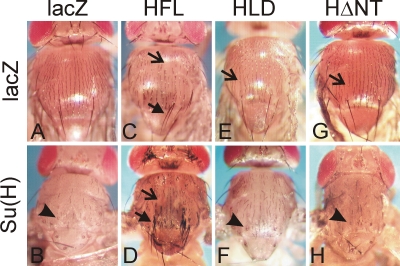FIGURE 7:
In vivo activity of Hairless mutant constructs. Wild-type and mutant constructs as indicated were expressed in the thorax of the developing fly using the MS1096-Gal4 driver line. Effects of Su(H) and Hairless on bristle development were studied singly and in combination to assay for the formation of a repressor complex. Open arrows (missing bristles due to transformation of external to internal fate) and closed arrows (ectopic bristles or double shafts) point to Notch loss-of-function phenotypes, and arrowheads (loss of bristles, double sockets) point to Notch gain-of-function phenotypes. Compared to the control (A), overexpression of wild-type Su(H) causes typical Notch gain-of-function phenotypes affecting the majority of macrochaetae and microchaetae (B). (C) Overexpression of full-length Hairless HFL results in Notch loss-of-function phenotypes affecting most macrochaetae and many microchaetae. (D) Combined overexpression of HFL and Su(H) enhances this effect strongly, and bushes of bristles appear as a result of reduced lateral inhibition. Flies resulting from overexpression of either Hairless mutant HLD (E) or HΔNT (G) have nearly wild-type phenotype. Moreover, in combination with Su(H) (F, H) the phenotypes are similar to the sole Su(H) overexpression (see B).

